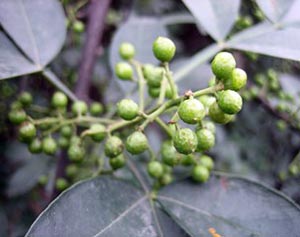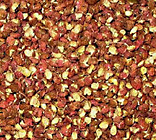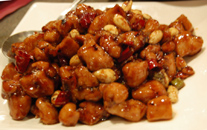Sichuan peppercorns (花椒) Nutrition facts
Sichuan peppercorns are actually the spicy "outer peel" of berries in the "prickly ash" family plants native to the Sichuan province of China. These sharp, pungent yet flavorful, rusty-red "peppercorn-like" coverings are one of the top ingredients employed in "Chinese five-spice" powder.
In the mainland China, they are popular as huājiāo.
Scientific name: Zanthoxylum simulans.
 |
| Green Szechuan peppercorn berries. Photo courtesy: Prince Roy |
Prickly-ash tree is a citrus family, a flowering plant native to the mountainous Szechuan region of China. It is a small-size tree featuring numerous short, stout spines appear on the woody branches and leaf petioles as in a lemon plant.
During winter, blossoms appear in slender cymes, which subsequently develop into tiny reddish-brown berries by the end of spring. Once the berry is ripe, it splits open to release round, black seeds from inside. What remains after deseeding is the "outer coat" (husk) which is gathered and employed as "Szechuan peppercorn spice," whereas their seeds are discarded.

|
| Close-up view. Note for rust red husks of peppercorns which used as a spice. |
Sichuan peppercorns differ from black peppercorns, which are native to the Indian subcontinent, in plant characteristics, aroma, and hotness. Sichuan peppers feature anise flavor with slight tangy taste and less pronounced pungency than black peppercorns.
Health benefits of Sichuan peppercorns
One of the popular ingredients of East Asian cooking, the peppers are indeed one of the richest sources of essential oils, minerals, vitamins, and antioxidants.
Unlike other pepper verities, Sichuan pepper contains unique essential oils, which give them a special citrus flavor with a biting, pungent taste. Their aromatic flavor comes to them from terpenes such as ß-myrcene, limonene, geraniol, linalool, cineol, citronellal, and di-pentene; whereas, their hotness character is due to certain alkamides embedded in their outer shell.
Like black peppercorns, Szechuan peppers also aid in the digestion power through increasing gastric juice and enzyme secretion inside the gut.
Szechuan peppers are also a good source of vitamins such as vitamin A, carotenes, pyridoxine, thiamin, and minerals like copper, potassium, iron, manganese, phosphorous, selenium, and zinc.
Medicinal uses
Native North Americans use the ground bark of the Szechuan plant as a remedy for toothache.
As in anise, these peppercorns also found application in traditional medicines as a stomachic, antiseptic, anti-spasmodic, carminative, digestive, expectorant, stimulant, and tonic.(Medical disclaimer).
Selection and storage
Sichuan peppercorns can be available year-round. You may find whole or ground peppers in jars, and in air-seal packets, especially in Chinese spice stores. Buy whole peppers (husk) instead of powder as you may need to use whole peppers in stews.
Peppercorns can be stored at room temperature for several months and can be milled using a hand mill, pestle, and mortar, or in a coffee grinder as and when required. Powdered pepper should be stored in the refrigerator in airtight containers.
Preparation and serving methods
Sichuan peppercorns commonly feature in Chinese, Tibetan, Taiwanese, Korean, Japanese, and Nepalese cooking. In mainland China, it is one of the main ingredients of five-spice
mixtures along with star anise, fennel seeds, clove, and cassia bark (cinnamon).As in other spices like coriander seeds, their flavor can be enhanced by gently roasting under low heat which is then added in stir-fries. In the case of stews and soups, whole peppercorns wrapped inside a cheesecloth are dipped until cooking is done, which is then removed just before serving.
Here are some preparation tips:

|
| Kung po chicken! A szechuan style chicken recipe. |
Sichuan peppers are popular ingredients featured in Szechwan cuisine, giving it bold and pungent flavors. Some of the favorite preparations that use peppers are kung pao chicken, wok-fried chicken, Bon bon chicken, mapo doufu, “hot pot” dish, etc.
The spice also features in traditional Tibetan cuisine to flavor rice-cake dumplings.
Sichuan pepper oil is added in noodles, chow mein, and in vegetable, fish, prawns stir-fries.
In Japan, dried leaves (Zanthoxylum piperitum (shansho)) are ground and added to dishes.
Safety profile
Although sichuan peppers are not as hot as chili, or black peppercorns, still they may cause some stomach upset, irritation, aggravation of stomach ulcers, etc., especially in those who have peptic ulcer disease. Therefore, recipes prepared with this pepper should be avoided in individuals with stomach ulcers, ulcerative colitis, and diverticulitis conditions. (Medical disclaimer).
≺≺ Back to Spices from Sichuan Peppercorns. Visit here for an impressive list of Healthy Spices with complete illustrations of their nutrition facts and health benefits.
≺≺ Back to Home page.
Further reading:
Gernot-Katzer's spice pages. (Opens in new window).
Stanford School of Medicine Cancer information Page- Nutrition to Reduce Cancer Risk.